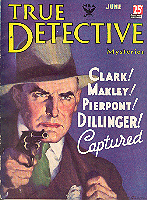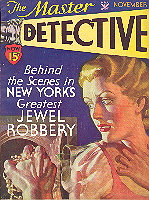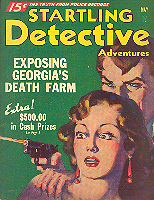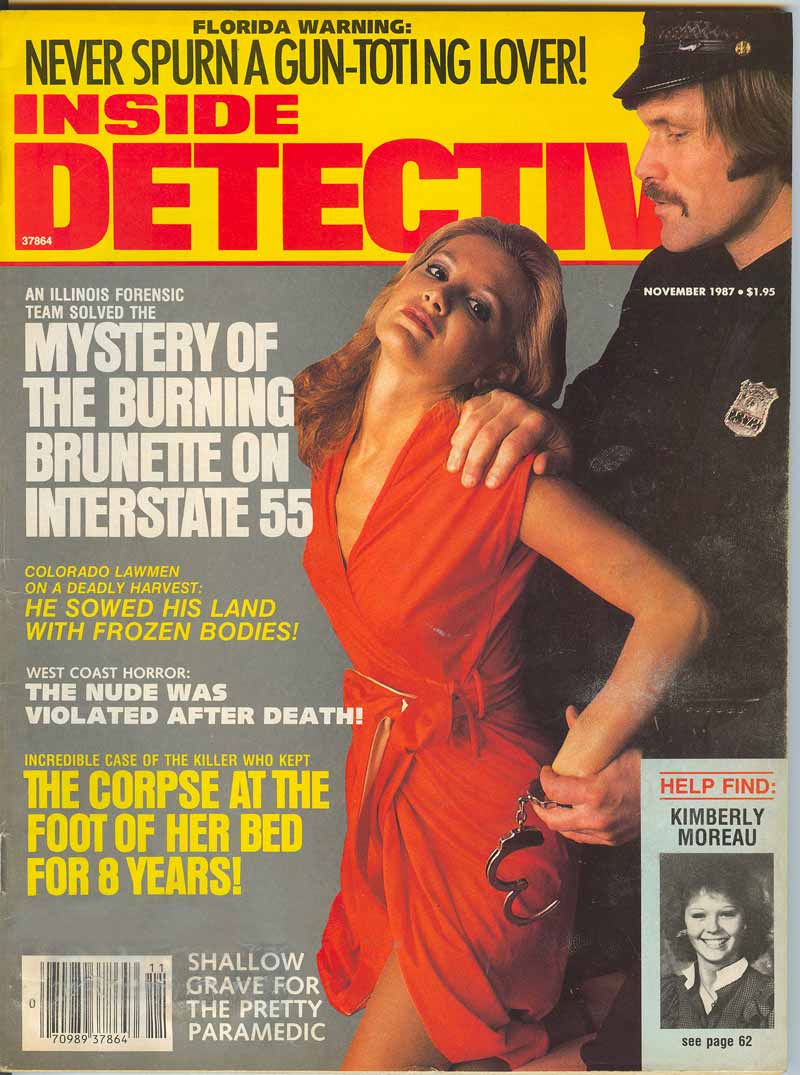



Let Patterson Smith be your source for back-date
True-Detective Magazines




Searching the bygone treasure trove of criminal history. In 1924 Bernarr Macfadden launched True Detective Mysteries. It flourished, attracted hosts of imitators, and established a new genre that for many years was one of the mostly widely read categories of American magazine. But as television grew into our main source of crime news, detective magazines went into decline and today are virtually extinct. In their 75-year wake, they left a vast—largely untapped—body of literature of great relevance to the scholars who study our criminal heritage, to historians of law-enforcement, to the sorrowful friends and relatives of crime victims, and to the de scendants of crimi nals themselves from whom poignant events in family history were often hidden. I’ve ex panded my rare-book business for any of you so situated and can now bring some of this history to you from my large inventory (see list) of back-date true-detective magazines from the 1920s through the 1990s.
If you seek magazines with accounts of famous cases: I usually have issues in stock with contemporary accounts of famous gangsters, such as Dillinger, Bonnie & Clyde, Al Capone, or of famous cases like the Lindbergh kidnaping, Sam Sheppard, or the Boston Strangler. Inquire.
If you seek a magazine with an article of personal interest: If you know the name of the magazine and the issue date, send me that information. I probably have it in stock or can get it for you.
If you don’t know the name or date of the magazine,
I may be able to locate it through my database of 60,000 detective-magazine
articles. I will let you know what I can turn up based on what you can tell
me about:
• Name of victim(s)
• Name of perpetrator(s)
• Location of the crime (city and state)
• Approximate year and brief account
If I am currently unable to supply the relevant magazine article, I may be able to do so in the future. I add about 100 cases a week to my database and find most published cases eventually. If you give me adequate contact information, I will make a case record and let you know when I turn something up. I don’t charge for this service (and I don’t share your information with others). What others say about my service.
If you want a bundle of magazines purely for your reading pleasure: I sometimes have overstock issues that I sell in small quantities at reduced prices. Inquire.
E-mail your magazine inquiry here: mail@patterson-smith.com.
FREQUENTLY ASKED QUESTIONS
ABOUT MY MAGAZINE SERVICE
Can you locate an article if I don’t
know which magazine it appeared in, or the date?
What information do you need?
What if I don’t have all that?
How long does it take you to check your database for an
article?
Can you locate an article by its title or author’s
name, or by the appearance of the magazine’s cover?
Does your database include every item in a magazine
issue?
If you can’t locate in your database an article
that I’m looking for, what then?
I’m nervous about giving a postal address over the
Internet. Why do you want it?
How many different magazines might publish an article
on a particular case?
How accurate are detective magazine articles?
What is the role of pseudonyms in the articles?
How long after a crime occurred did an article on it
appear?
If I’m interested in articles by a certain
author, regardless of content, can you help?
Where do you get your magazines?
What was the so-called Golden Age of the detective magazine?
Are these magazines published today?
How many different detective magazines were there?
Do you handle detective fiction or mystery fiction
magazines?
Who are your customers?
What sort of customers have personal involvement?
Why are you doing this?
Can you locate an article if I don’t know
which magazine it appeared in, or the date?
Not always, but often. I have a database of 30,000 articles
in over 2,000 issues that I can key into with the right information.
What information do you need?
Preferably, the names of the victim(s), the perpetrator(s),
the location (city and state), the year, and a brief account of the event.
What if I don’t have all that?
Give me what information you have and I’ll let
you know if it’s adequate.
How long does it take you to check your database for
an article?
In most cases I can get back to you within 48 hours.
Can you locate an article by its title or author’s
name, or by the appearance of the magazine’s cover?
Not usually. My database is strictly content-based. I
need to know the who, where, and what of the article’s contents. If you
happen know the author, title or cover, that can be useful in verifying the
article when located, but it won’t facilitate my search.
Does your database include every item in a
magazine issue?
No, only articles of a page or more in length (with minor
exceptions).
If you can’t locate in your database an article
that I’m looking for, what then?
If you give me back-up contact information (such as postal
address or phone) that I can use if your e-mail address changes, I will make
a case record based on the information you have provided and add it to my target
list. Every week I add about a hundred new articles to my database and check
them against my target list. When I find a match, I e-mail you.
I’m nervous about giving a postal address or
phone number over the Internet. Why do you want it?
If your case is not in my database at the time you inquire,
it could take weeks or months before I come across it. In my experience, there
is about one chance in three that your e-mail address will have changed during
that period. It bums me out if I have no way of getting in touch with you after
a long slog before hitting your case. There is the further point that I obviously
need an address to which to send the magazine if you purchase it. (Incidentally,
I don’t share customer information with others, nor do I keep it on my
web-site, so there’s no danger from hackers.)
How many different magazines might publish
an article on a particular case?
Major cases, such as Arnold Rothstein or Winnie Ruth
Judd, received widespread coverage. Less-notorious cases, which are the ones
most likely to be of interest personally, appeared normally in only one magazine,
but there were many exceptions that were covered in two, three, and possibly
even more issues.
How accurate are detective magazine articles?
As far as I know, there has never been a study made of
this question. My impression is that they are generally accurate in all major
respects. I suspect that patches of dialogue are often fabricated to give the
story narrative sweep. And since their authors relied on personal interviews
with detectives, sheriffs and policemen, they tell the story from law enforcement’s
point of view.
What is the role of pseudonyms in the articles?
Names of murder victims are always identified in the
articles, and perpetrators nearly always. In many other cases, the editors
substitute pseudonyms. Women and girls who survived sexual attack are almost
always given pseudonyms. The names of witnesses and other participants are
often hidden behind pseudonyms to preserve their privacy, even when their role
is blameless. Sometimes lesser offenders deemed to have “gone straight”
or "deserving of another chance” are given pseudonyms. Law enforcement
personnel are nearly always identified except for Secret Service and Treasury
agents and, occasionally, FBI agents. Pseudonyms are not ordinarily an impediment
to family research, since readers connected to the case usually know the identities
of those involved.
How long after a crime occurred
did an article on it appear?
Usually two to six months after the event. Classic cases
or particularly intriguing crimes were sometimes reprised years afterwards.
If I’m interested in articles by a certain
author, regardless of content, can you help?
If you know which magazine and the date range, I might
be able to spot such an author when I have the magazine in front of me, but
it’s catch as catch can.
Where do you get your magazines?
Many years ago I purchased the archives of Dell Publishing,
which at that time published Front Page Detective and Inside Detective.
In addition to runs of these two titles, the archive contained copies of competing
magazines with which Dell had an exchange relationship. This acquisition formed
the basis of my magazine inventory, which I have augmented over the years with
purchases from other sources.
What was the so-called Golden Age of the detective
magazine?
The early and mid 1930s, when the major crimes figures
of the Depression, like Bonnie and Clyde and the Barker gang roamed the Midwest.
These bandits were themselves avid readers of the genre.
Are these magazines published today?
Generally speaking, they
have died out. True Detective, the progenitor that began in 1924,
published its last issue in 1995. (A British publisher that currently uses
that name is unconnected with the original magazine.)
How many different detective magazines were there?
No census has ever been taken, but since their advent
in the 1920s there had to have been several hundred magazine titles and many
thousands of different issues.
Do you handle detective fiction or mystery
fiction magazines?
No.
Who are your customers?
There are various categories: (1) collectors of major
crime figures, such as Dillinger, and of major cases, such as the Lindbergh
kidnapping; (2) authors and researchers gathering material on specific crimes
in which they have a scholarly interest; (3) family members or friends with
a personal relationship to the victim or to the perpetrator; (4) detectives
and law-enforcement men who worked on the case.
What sort of customers have personal involvement?
I don’t ask for personal details, so I know only
what customers volunteer. About 40% are male and 60% female. About 20% tell
of a personal relationship with the victim, about 15% with the perpetrator,
and about 10% with a law enforcement officer. In over half the cases I don’t
have a clue.
Why are you doing this?
I’ve been an antiquarian bookseller specializing
in criminal history for many decades, selling chiefly books and criminal ephemera.
When I began posting to the Internet, I found that more and more people who
were personally involved in a crime, through family or friends, were contacting
me in search of information on that crime, either to compile a family history
or to seek closure on a tragic event. It was a hunger for information that
they could not satisfy through libraries, newspapers, or even through the vast
resources of the Internet. I came to realize it would serve a need if I could
make available to these people the resources of my large magazine inventory.
Thanks for visiting my web-site. -- Patterson Smith.